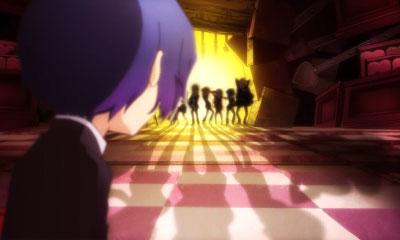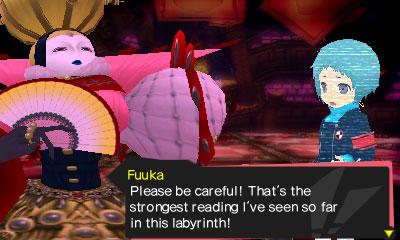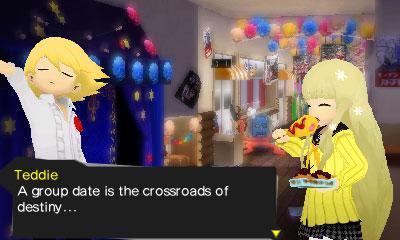“Persona Q is rich with characters and tactical pursuits, familiar but slightly tweaked to make for something new.”
- Rhythm of mapping dungeons is a distinct treat.
- Excellent weird art.
- Involving, punishing strategic fights.
- Set up is almost too similar to Persona 4: Arena.
- Very little drama outside of fan fiction.
Small talk is nothing to be dismissed. Anyone bemoaning idle chatter, ask yourself: How the hell else are you supposed to get to know people? Everything starts somewhere. Friendship, romance, and rivalry are born from sitting around and jawing with strangers about the weather. Persona 3 and Persona 4 stoke their inner fires with small talk. Strategic character building, bizarre art, catchy music and skewed world building; these strengths grow out of idle conversation’s fertile soil.
Which is perhaps why Persona Q: Shadow of the Labyrinth feels somewhat hollow. As a side story fusing those third and fourth games together, it’s rich with characters and tactical pursuits, both familiar but slightly tweaked to make for something new. Without the scads of small talk, though, Persona Q feels lost in the shadow of its parent series.
Without the scads of small talk, Persona Q feels lost in the shadow of its parent series.
Familiarity with that parent series is a prerequisite for milking the most out of Persona Q. Spun directly off of Persona 3 and 4 taking place in medias res for both, Q is also modeled on Atlus’ punishing dungeon exploration series, Etrian Odyssey. Unlike story-light Etrian, Q is full of dialogue scenes wherein its 18-character cast of familiar faces chats up a storm, typically making in-jokes about what they’ve been up to in their respective games.
You want examples? Callbacks to Kanji and Teddie’s star turns in a drag contest abound, while Akihiko and Chie regularly commiserate about inadequate available, edible meat. If you don’t know who those people are or what those references mean, Q is definitively not for you.
Which isn’t to say the idea for a crossover between these two casts isn’t fertile ground for a great game that remains friendly to folks without prior series love. The Persona 4: Arena fighting games have already been surprisingly successful at that. In fact, Q lifts many of Arena‘s basics.
As in those fighting games, the respective teams of teenagers and the powerful Persona creatures that they summon are whisked away to a strange place and forced to fight for their freedom. They’re once again trapped in a freaky mirror image of the P4 crew’s school, only this one houses five hallucinatory labyrinths themed around a Cultural Festival.
Familiar or not, Q‘s setup is discussion-worthy. Wrenched out of their own stories, the P3 and P4 teams have to plumb the depths of four unmapped labyrinths to unlock a mysterious clock tower and, hopefully, a way home. Mapping and fighting through those labyrinths is how you spend most of your time, and there’s an unusual rhythm to the process.
Laid out on a grid, you explore each floor of a labyrinth in first person, drawing in the walls, doors between rooms, shortcuts, and traps as you go on the lower screen of the Nintendo 3DS. At first it’s cumbersome, walking forward a couple of steps and trying to orient yourself in the cramped first-person view. Is that a treasure chest a few steps away or just part of the crumbling clocks and flowers pastiche wallpaper in the Alice in Wonderland-themed first labyrinth?

As the hours pass, the flow of Q becomes both intoxicating and enervating. Your five-person party builds strength as you map out each room and floor. But dungeons are dangerous! Before too long you have to head back to the school nurse’s office, to sell items culled from downed enemies and stock up on supplies. Then it’s back to the now-mapped dungeon where a new set of enemies awaits, but you’re stronger and better than you were before. It feels far more fulfilling than it should for such a grueling pastime.
And then, sometimes, it is a slog. When you push through to the next floor without heading back to school, only to get wiped out by a giant bug wearing a crown, Q can feel needlessly vicious. The one-more-turn mentality drives you excitedly, anxiously forward, but it’s downright lethal when beating a strategic retreat back to base is the only way to save your progress. What’s the reward here?
One reward, at least, is the satisfaction of actually beating that bug, along with the other assorted freaks haunting Q‘s labyrinths. The labyrinths themselves are fairly varied, as are their floors. One second you’re in an unsettling dating-themed dungeon, and the next a pitch-black haunted house where you have to figure out how to light your way.

The enemies, however, are mostly familiar. For the first dozen hours of the game, the abstract freaks you fight in turn-based skirmishes are loaners from P3 and P4, with the exception of bosses and FOEs. (FOEs are giant enemies that move in patterns and are actually visible on the map. Some of the best parts of the game are figuring out how to avoid them on the grid.)
Beating the opposition requires cunning use of Personas, which work a little differently in Q than they have before. Fights play out like ridiculously complex rock-paper-scissor matches, with monsters typically weak to certain types of attack. Flying paper dolphins don’t like lightning attacks? Make sure to have Persona that use lightning. In a twist, though, all party members can equip a secondary Persona in addition to their character specific demon pal, meaning you can custom fit a team of fighters to each labyrinth.
Health and magic are painfully limited, so having properly equipped Personas on the whole party is essential. Pride born out of kitting out a perfect party with just the right summons, and fusing new ones by combining others in your collection, are the other rewards of plumbing further and further into the labyrinths.

Those are the only rewards, though, which is where Q falters. There’s not much to do outside the dungeons even after you’ve beaten the first labyrinth and Q opens up a bit. Taking a “Stroll” through the phantom high school culture fest leads to cute vignettes where the characters get to know each other a little. There are also sidequests to take on, which sometimes involve goofy dialogue puzzles, like where you have to trade food to find the ultimate treat for Rei before perv bear Teddie does. But they’re just quick diversions, picked out of a menu.
The hours of dialogue and incidental conversations that make up most of your time in Persona 3 and 4 are simply gone here. There’s no one new to meet, no odd jobs to take on for pocket cash. Without the process of meeting new people, which was how you powered up Personas in those games, the process of building an arsenal feels rote and mechanical. While there’s plenty of fan fodder in seeing the old casts hang out, there’s not much new to discover about them.
The small talk, the mundane humanity isn’t there to balance out the machine high of dungeon diving and level grinding. On the bright side, Persona Q is literally jammed with superlative dungeon diving and level grinding. If you like nothing more than the careful precision of mean, turn-based fights, slow progress through multi-tiered hellholes full of monsters, and some familiar faces, this is sure to please. For anyone looking to find the Persona series’ soulful small talk, however, Q is not your ideal conversationalist.
This game was reviewed on a Nintendo 3DS using a code provided by Atlus.
Highs
- Rhythm of mapping dungeons is a distinct treat.
Excellent weird art.
Involving, punishing strategic fights.
Lows
- Set up is almost too similar to Persona 4: Arena.
Very little drama outside of fan fiction.











